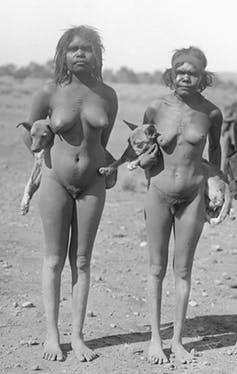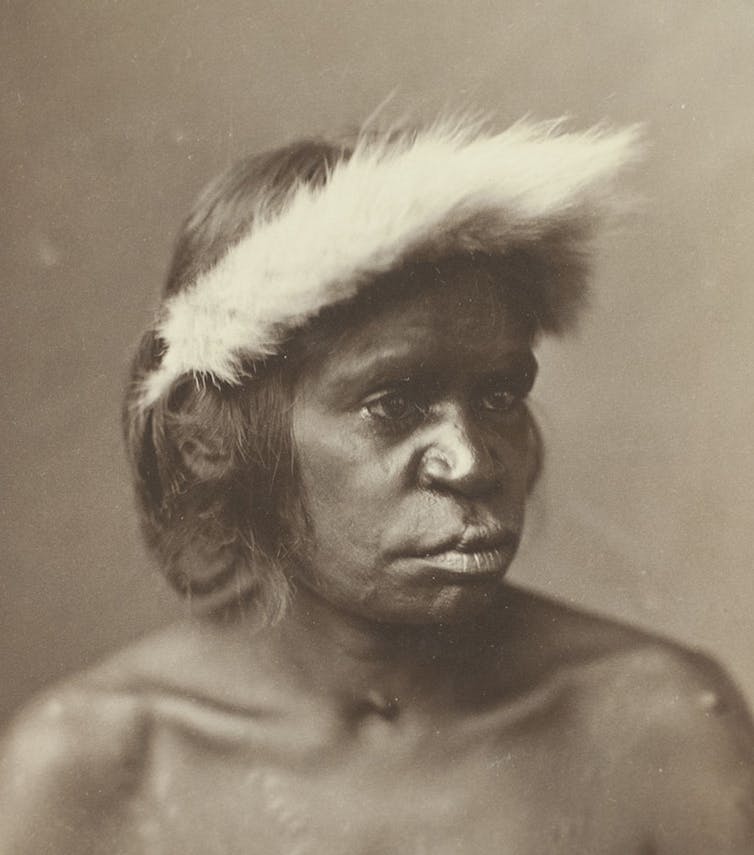The cultural history of the dingo

Members of Aboriginal communities are warned that this story may contain images and names of deceased people.
In traditional Aboriginal society, women travelled with canine companions draped around their waists like garments of clothing. Dingoes played an important role in the protection and mobility of the women and children, and are believed to have greatly extended women’s contribution to the traditional economy and food supply.

Dingo pups were taken from the wild when very young. The pups were a highly valued ritual food source, while others were adopted into human society. They grew up in the company of women and children, providing an effective hunting aid, a living blanket and guarding against intruders.
Nursing young dingo pups was also deeply embedded in traditional customs. Interspecies breastfeeding of mammalian young was common in most human societies pre-industrialisation, historically providing the only safe way to ensure the survival of motherless mammalian young. Technological advances in milk pasteurisation made artificial feeding a viable alternative by the late 1800s.
Cohabitation with human society represented a transient phase of the dingo’s lifecycle: the pups generally returned to the wild once mature (at one or two years of age) to breed. As such, dingoes maintained the dual roles of human companion and top-order predator – retaining their independent and essentially wild nature over thousands of years.
Post-colonisation, it became too dangerous to keep the semi-wild canines in the Aboriginal camps. Dingoes were targeted for eradication as livestock holdings spread across the country. Their removal would have had a profound impact on the women, resulting in a great loss of traditional knowledge and status.
DNA studies estimate that the dingo arrived on the Australian continent between 4,700 and 18,000 years ago, representing perhaps the earliest example of human-assisted oceanic migration. They were adopted into Aboriginal society, maintaining a symbiotic partnership that lasted thousands of years, and for this reason have been celebrated as a cultural keystone species.
The dingo’s ability to locate water above and below ground was perhaps its most indispensable skill. Written records, artworks and photographs in museum archives reveal dingo water knowledge as recorded by European explorers. Records reveal a number of accounts of wild/semi-wild dingoes leading Europeans to lifesaving water springs.
In Australian cartography, a “Dingo Soak” refers to a waterhole dug by a mythical or live canine. There are other freshwater landmarks across the continent – “Dingo Springs”, “Dingo Rock”, “Dingo Gap”.
In Aboriginal mythology, the travels of ancestral dingoes map out songlines, graphemic maps tracing pathways across the continent from one water source to the next. Their stories tell of the formation of mountains, waterholes and star constellations. In some accounts, dingoes emerged from the ground as rainbows; in others they dug the waterholes and made waterfalls as they travelled through the landscape.
Ethnographic evidence
Human-dingo heritage is preserved in ethnographic collections in Paris, London and Washington DC. Artefacts include talismans and ornaments made of canine teeth, bones and fur; rain incarnations and love charms. Funerary containers were decorated with dingo teeth, providing protection for the spirit in the afterlife.
In one portrait from the Smithsonian collection, an Aboriginal woman wears a dingo tail headdress – a talisman believed to hold great power and worn by warriors going to battle.

The Smithsonian Institutional Archives also reveal a wealth of information about the post-colonial social history of the dingo. Many semi-wild dingoes were kept in early Euro-Australian settlements, then transported live to England, France and later to America as diplomatic gifts or exotic animal displays.
It was noted that the dingoes remained essentially wild despite numerous attempts to domesticate them – they failed to respond to any amount of discipline, kindness, bribery or coercion. Despite 230 years of surviving on the fringes of human settlements, travelling in menageries and circus troupes, living in zoos and semi-domestic arrangements, this remains true today. The dingo has retained its independent character and irreversible prey drive.
However, they did breed quite well in captivity and zoos often had excess pups to trade. Occasionally these pups went to private homes. Affectionate and tractable when young, eventually their carnivorous nature would get the better of them. The majority soon ended up in difficult circumstances and back in the hands of officials.
A Roosevelt connection
The Smithsonian holds records of the first live dingoes to arrive in Washington DC in 1901, a gift from the US consul to New South Wales. A number of pups were later born at the National Zoo and documented in the daybooks and records of births, deaths, sales and exchange.
One file contains a curious letter, offering a home to one of the dingo pups on display, dated May 14 1908. The request for the pup was signed by Theodore Roosevelt junior. At the time, Theodore’s father was in office as the 26th president of the United States, and the Roosevelt family were in residence at the White House.
The Roosevelt children were well known for their eclectic pet collection. Many arrived as diplomatic gifts and ended up at the National Zoo, or were traded through the local Schmid’s Bird and Pet Animal Emporium at 712 12th Street NW. The list included snakes (which ended up, uninvited, in the Oval Office) and a pig, smuggled into the presidential residence under the care of a young Quentin Roosevelt.
The pig, once discovered, ended up in Schmid’s Emporium for sale under a sign stating: “this pig slept last night in the White House”. No records have surfaced about the Roosevelts’ dingo. However, five months later – around the time that the pup would have been challenging all boundaries of domestication – a sale notice appeared in The Washington Post, dated October 16 1908, under: DOGS, PETS, ETC. “JUST RECEIVED, Dingo, Australian wild dog … SCHMID’S BIRD STORE 712 12TH.”
Baudin’s dingoes
The first live exhibit of dingoes in an international display appeared in the Ménagerie du Jardin des Plantes in Paris in 1803. The pair, a male and female, had been collected by Captain Nicholas Baudin in Port Jackson, and transported to France on Le Naturalist in the care of François Péron (zoologist) and Charles-Alexandre Lesueur (artist).
Frederick Cuvier, naturalist and zookeeper, was assigned to care for the dingoes in Paris. In 1924, he wrote:
This dog, who was female, was about eighteen months when she arrived in Europe. She lived in freedom in the vessel where she was embarked, and despite the corrections inflicted on her, as well as a young male that died as a result of a punishment too harsh, she continued to evade punishment and consume all that suited her appetite.
The female lived for seven years in the gardens, the male survived just two months after arrival.
Eventually the bodies of both were transferred to the stores of the Muséum national d’Histoire naturelle and preserved for perpetuity. Notes in the museum state that early on in the voyage of Le Naturalist, before departing King Island for France, the male dingo had “been too brutally castrated because of his independent character” and these injuries eventually killed him.
The taxidermy specimens remain in the vaults of the museum today.
NASA’s dingo encounter
In 2006, a team of NASA scientists from the Smithsonian’s Centre for Earth and Planetary Studies were in Australia’s Simpson Desert studying the formation of parallel desert dunes similar to those found on Mars.
Senior scientist Ted Maxwell took a photo of a wild dingo casually observing the scientists while they were staking out a dune on the Colson Track. Maxwell recorded the co-ordinates of their location, noting that it was a 60-kilometre journey across the desert to Dalhousie Springs, the nearest known permanent water source. The dingo appears completely at ease.

Another reference to a dingo appears in the Smithsonian records in 2014, this time as the NASA Curiosity Rover crossed the Martian landscape. The vehicle passed an ancient dried freshwater lake on Mars, before travelling up through “Dingo Gap” in the sand dunes.
The NASA scientists had mapped the surface of Mars into quadrangles, and named the locations after sites on Earth with a similar ancient geology or rock formations. Dingo Gap is named after a location near the remote Kimberly quadrangle in Western Australia.
![]() So, in contemporary celestial narrative, a valley on the Martian landscape is named after the Australian wild dog, the dingo, that thrived for thousands of years in one of the most extreme environments on Earth.
So, in contemporary celestial narrative, a valley on the Martian landscape is named after the Australian wild dog, the dingo, that thrived for thousands of years in one of the most extreme environments on Earth.
Justine M. Philip is a Doctor of Philosophy, Ecosystem Management at the University of New England.
This article was originally published on The Conversation. Read the original article.





